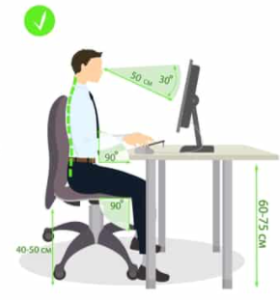This is the Covid era, when we stay at home to do our jobs or learn our lessons. Those of us who didn’t already have a home office have had to adapt, working at kitchen or dining tables, or breakfast bars.

But, says occupational therapist Shannon Clearwater, sitting for long periods at the wrong surface height can cause strain or even damage – “to our hips, necks, arms, back, shoulders and wrists, as well as our eyes. The whole body can be affected by the height of a chair or the angle of a screen.”
***
Here is Clearwater’s checklist to help us assess the chair we use to work or learn in …
- Are your feet flat on the floor?
- Are your knees slightly lower than your hips, to take pressure off your lower back?
- Are your shoulders relaxed?
- Are your elbows at 90 degrees when working at your keyboard?
“If your arms are lower than table height – which is common – then you will be straining to reach the keyboard,” she says. “The remedy, if you don’t have an adjustable chair, is to sit on a cushion to raise yourself up.”

But, Clearwater warns, once raised up, a person’s feet might not reach the floor. “Then you need a foot rest. There are good ones out there to purchase, but a phone book or an encyclopedia under your feet works as well.”
***
Regularly, during the working day, we should run self-scans to check for tension. “And we should get up and move, often. Workers who take breaks are more effective than those who just power through. Even a 30-second break in a 90-minute stretch of computer use helps.
“Get up, get water, take a lap around the kitchen,” she advises. “We need to keep the blood flowing. We are not meant to be static. Be dynamic.”
It’s the same for children. Not everyone has a toddler table at home, but children can sit on a cushion at a dining room table. And they shouldn’t strain their necks to see the screen. “I made my daughter an angled surface for iPad use, so the screen meets her at eye level.”
Elsbeth Lindner is Editor of River Journal.







